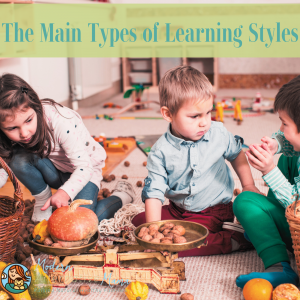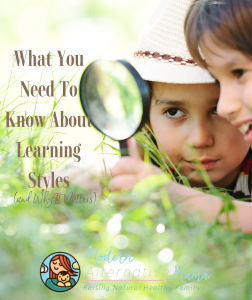By Rustina, Contributing Writer
Ever find yourself repeating the same information over and over until you feel like no one is listening to you? They may be trying their best, but they just are having a hard time following the teaching path you are taking. Just like we each live in our own unique way in this world, we do not think the same either – and that is good! If we all processed information the same or taught the same, then we never would have advanced the way we have as a people. We need different so we can grow, heal what is broken, and expand our minds further.
Learning how we process information (also called our learning style), helps us figure out how to help people better and how to convey our own thoughts better. I never gave it much thought until I started down our homeschooling path back in 2013. It has become a very useful tool and practice for us.
Why It Matters to Know Yours and Your Child’s Learning Style
It is important to observe your child learning naturally. Just doing what they do, nothing being forced or intentionally taught to them. That way you can really see their mind working. Some children are very visual (wanting to see a video to learn), some hands on (“just hand it to me so I can see it”), some need to have the audio (“please read this again to me”), etc. Knowing how they understand helps you convey what you want to teach them. Both of you can find this a very useful tool to help them on their life’s path.
They will and should experience all the many learning styles yet, not just that one. But especially when they are struggling or learning a more complicated subject, knowing their most comfortable method can make a huge difference!
Is it controversial?
Some look at the test results of schools that have attempted applying the different styles for each of their students, and they will say it clearly makes no difference. As a homeschooler, I can understand that in a large classroom, teaching a class with so many different learning styles, would be a very difficult and different application. My views on the testing practices are also at odds with this. There are so many factors that cannot always be taken into account with testing in a classroom. Testing isn’t an end all way to determine a child’s understanding or mastery of a skill! So many kids actually ARE left behind this way! Home educating offers the unique ability and time to explore these concepts and more individual time with each child. To me, this isn’t controversial. It’s logical.
The Main Types of Learning Styles
There are 4 main learning styles
- Visual
- Auditory
- Kinesthetic
- Reading
There are many more styles to learning than what I can mention in a short blog, but these give a good starting idea to finding what works for your family.
Visual
Visual, or spatial if you prefer, learners are the ones who learn best when they can see it; either demonstrations, pictures, or videos that show and describe the process being taught. Graphs and charts are their go to’s (and ways to get their attention).
Auditory
Auditory or sometimes called musical learners are the ones who like to hear it. They may love audio books or listening to a video or music while they play. That background music may sometimes calm them into their focus or it may distract them, but rest assured, it affects them. They learn well by listening to lectures also.
Kinesthetic
Kinesthetic or hands-on learners need to touch it, feel it, and be a part of the process to understand it well. They like experiments, arts and crafts time. They are doers and movers, often not enjoying sitting still for long. They are the first to jump into the obstacle courses and figure it out as they go.
Reading
Although sometimes combined with auditory learners, I will choose to also keep them separate. That is because I am a reading learner but auditory often shuts me down. Reading learners love taking notes, outlining, researching, group chat discussions, and are especially fond of word games like scrabble.
Additional Layers to Learning Styles
Most people still have a root in one of the above learning styles. Some psychologists suggest there are hundreds of learning styles, and they may be right! The above are the most basic, but there are additional ones that I like to look at as “layers” of learning. They add more options to reach out through.
Some examples are:
- Naturalistic learners are drawn in by their surroundings – especially the outdoors.
- Analytical learners are always seeking more information and facts to process, craving more details to understand so they can find their own conclusions.
- Sensing learners are similar to analytical in their gathering of facts, but like to do it in a methodical process – without surprises or complications please! Analytical learners follow the information without stressing over process or problems.
- Active learners gather information, but they need to actively do something with the information to process it well. We can use the always fun example of “don’t touch that, the paint is wet!” – an active learner is going to have a painted hand lol!
- Intuitive learners are not interested in the gathered information, they want to experience the feeling and relationship of the information or events. They like innovation and do not have the patience for repetition.
- Reflective learners like to take the information and really process through the steps. While an active learner says “ok, let’s go ahead and talk about this now,” the reflective learners are the quiet ones thinking it through and preferring to do so by themselves without group discussions.
How You Can Apply This
Once you have an idea how best to communicate subjects with your child, then it is easier to find ways to nurture their path. In our homeschool, I have a mix of visual, auditory, and kinesthetic as well as a mix of analytical, reflective, and active layers, while I prefer reading and analytical learning styles.
We do most of our instructional education in the form of discussions and follow it up with researching using a variety of learning types (visual, audio, reading/writing, and hands on) so it catches on with each of them in their preferred way. Be sure not to limit the style of learning to only their preference, but use it to help support them when extra help is needed or when you suspect a subject may be difficult. After all, variety is the spice of life!
As an example, after we read a book together, I might offer discussions about topics along with related videos or the movie version if available, drawing activities, a sensory box with items/colors from the story, music to sing, scenarios to act out, some written math problems that are presented in the book, and/or science experiments. It makes it relatable to all ages in some way and shows that everything can be connected, just like with us and nature. It isn’t just math or just spelling; it is a little of everything and everyone has a talent in there to celebrate and work on harder.
How To Identify Your Child’s Learning Style (and Yours also)
I recommend having your child answer these questions in the link below (helping them if they are younger), and then taking time to observe and talk about it with your child for the next couple of weeks. Then, answer the questions again. Check back every once in a while too; you never know when you might see something different!
https://cf.ltkcdn.net/kids/files/3923-Kids-Learning-Style-Survey.pdf
Here are some additional sources to help you identify the learning styles in your family:
- Supporting Teachers in Identifying Students’ Learning Styles in Learning Management Systems An Automatic Student Modelling Approach
- Discover Your Child’s Learning Style
- What’s Your Teaching Style
- an additional: What Type of Learner is my Child
- The Way They Learn
- Our Unschoolers Education Plan
These are some of the educational sources we have available also to use and adapt for your child’s education:
- Learn to Homestead: Spring is in the Air
- Learn to Homestead: Wild Berries
- Learn to Homestead: Respiratory Remedies
- Learn to Homestead: Fall Fruit
- Herbal Flashcards
- An Herb Garden Unit Study
- A Spring Garden Unit Study
- Real Food, Real Nutrition: A Healthy Nutrition Curriculum
- Learning at Home: Family Edition
- The Green Family Goes Wildcrafting
- The Green Family Goes Wildcrafting Activity Book
- The Green Family Gets the Sniffles
- The Green Family Gets the Sniffles Activity Book
- The Green Family Goes to Homeschool Co-op
- The Green Family Goes to Homeschool Co-op Activity Book
- Resources for Young Engineers



